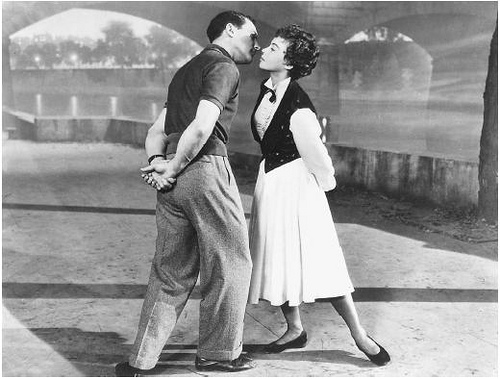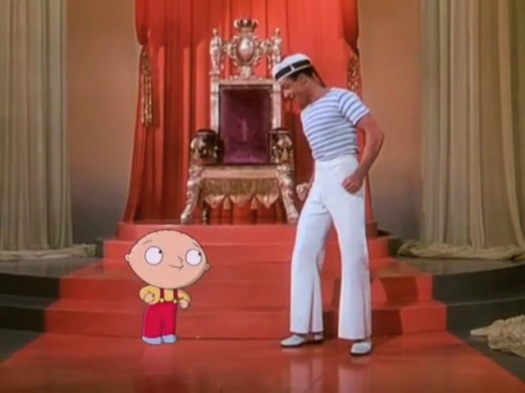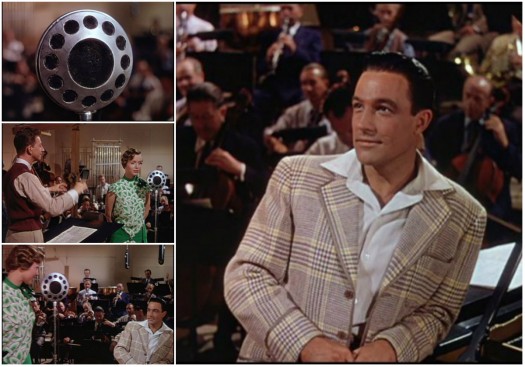
The following post by Kelli Marshall is part of our online companion to our Winter 2013 issue on Classic Hollywood. Click here for an overview of the issue.
———
On August 23, 2012, Gene Kelly would have turned 100 years old. One might not think the centennial of a classical Hollywood musical star who has been deceased for sixteen years would garner much attention. But in fact, global celebrations of the song-and-dance man kicked off nearly seven months prior to his 100th birthday with radio documentaries and week-long film festivals, one of which even featured a “Gene Kelly ceilidh” (Scottish gathering) after its screening of Brigadoon (1954).
As Kelly’s centenary grew closer, the festivities heated up. For instance, July and August 2012 yielded Gene Kelly floral displays, a twenty-three-film salute from Lincoln Center, the University of Pittsburgh’s record-breaking umbrella dance, and in theatres nationwide the presentation of a digitally remastered Singin’ in the Rain (1952). Significantly, celebrations of Gene Kelly and his legacy are still going on. In 2013 for example, some audiences will be treated to screenings of Singin’ in the Rain with live accompaniment by the Royal Philharmonic Concert Orchestra and the Chicago Symphony Orchestra.
So what is it about this man that elicits such worldwide commemoration? Why are radio stations, television programs, film distributors, orchestras, freshman classes, arboretums, and fans in general still paying homage to a star whose popularity was at its height around WWII?
Naysayers will claim that some of the hoopla is not necessarily for Gene Kelly but for Singin’ in the Rain, which also just celebrated its (sixtieth) anniversary. Fair point, but I would maintain that of all the musicals in Hollywood’s canon, this one may be the most difficult to separate from its star, who also directed and choreographed the picture. Others will say that most of Kelly’s cinematic oeuvre, as well as his charming and boyish star persona, conveys unabashed joy, so why not publicly celebrate it as long as popular culture and the media will allow?
Moreover, in the past four years, Kelly has starred in Family Guy (below), a Funny or Die sketch, and at least three advertisements—plus several television shows (So You Think You Can Dance, Strictly Come Dancing) and music artists (Usher, Jaime Cullum) have celebrated him and Singin’ in the Rain. So despite his age and presumed irrelevancy, people still know who he is and appreciate his talents.

Finally, when asked to give a reason for all these festivities, some will (correctly) assert that despite his films’ simplistic stories and conservative characterizations, Gene Kelly is unequivocally (post)modern. He experiments with form and narrative in An American in Paris (1951) and Invitation to the Dance (1956). He plays with the film medium itself in Cover Girl (1944) and Anchors Aweigh (1945). And he parodies Hollywood’s impending demise-by-television in It’s Always Fair Weather (1955). As Boston Globe staff writer and sometime-professor Mark Feeney explains, “There’s this fundamental restlessness to Kelly. In terpsichorean [or dancing] terms, he’s always lighting out for the territory, seeking something new, better, different …”
These are all valid reasons Gene Kelly and his centennial were/are being widely observed across the globe, but let me offer a more personal one.
I rarely cry during movies or television shows. I do not swoon over couples in most romantic comedies. I’m normally not the spectator who gets attached emotionally to her moving pictures, at least not in the lovey-dovey sense. But there are a handful of male stars and films out there that can affect me in such a manner—for example, Colin Firth in Love Actually (2003), Colin Firth in Bridget Jones’s Diary (2001), Colin Firth in Pride and Prejudice (1995), and … okay, Colin Firth in almost anything including A Single Man (2009) in which he (heartbreakingly) plays a gay widower on the path to suicide.
Evoking similar feelings in me is Gene Kelly. While there are certain moments in most of Kelly’s film musicals that affect me, there’s one shot in particular from Singin’ in the Rain I look forward to every time I watch. It’s random. It’s not funny. It’s not part of a song-and-dance number. Honestly, it’s not all that remarkable. But I am smitten and elated every time I see it. It falls about seventy minutes into the film after Kelly’s iconic “Singin’ in the Rain” and after his character Don Lockwood, Cosmo Brown (Donald O’Connor), and studio producer R.F. Simpson (Millard Mitchell), agree to adapt the ill-fated The Dueling Cavalier into the musical The Dancing Cavalier.
The shot begins with an extreme close-up of a microphone and tracks back to reveal Kathy Seldon (Debbie Reynolds) dubbing the song “Would You?” for Jean Hagen’s shrill-sounding Lina Lamont (trivia: Reynolds was actually dubbed here by singer Betty Noyes). The camera continues its movement to reveal Cosmo conducting a full orchestra. After that, it slowly pans to the right, from Cosmo and Kathy to Kelly’s Don Lockwood, who watches the performance. Now, just a small move forward, and there you have it: the one shot of Singin’ in the Rain that gets me every time.

As Don Lockwood, Gene Kelly rests his upper body on a baby grand piano and stares adoringly at Reynolds’s Kathy Seldon. The glamorous three-point lighting, Kelly’s olive complexion, and the use of shallow focus separate the star from the orchestra playing in the background. At this point, I don’t think of Kelly’s toupee or that less-than-sexy jacket he’s sporting (which he also wears in Take Me Out to the Ballgame). It’s just Gene/Don and me, with the former looking affectionately at me in the manner he’s looking at Kathy. The shot continues for a few more seconds. It pans left as Don walks in front of Kathy, and then it centers all three players in the frame, Don still gazing tenderly at the girl who “was meant for him.”
Why do such shots of Gene Kelly (or Colin Firth) move me in this manner, but nothing from Ryan Reynolds in The Proposal (2009), John Corbett in My Big Fat Greek Wedding (2002), Mel Gibson in What Women Want (2000), Hugh Grant in Notting Hill (1999), Bill Murray in Groundhog Day (1993), or Channing Tatum in anything does? Or turning to classical Hollywood, why do I remain mostly unaffected by Cary Grant in Bringing Up Baby (1938), Clark Gable in Gone with the Wind (1939), or Rex Harrison in My Fair Lady (1964)?
The first, visceral reaction I have to these questions is that I think Gene Kelly is hot. Second, I have an interest in Kelly that I do not have with, say, Reynolds, Tatum, or Gable. While each actor/star may be attractive and may perform well on-screen, none fascinates me in the way that Kelly does, which leads me to my third response. I am attracted to Gene Kelly’s talents—his dancing ability and choreographic skills as well as his innovations in staging and cinematography. Although a perfectionist and evidently hard-nosed on (and off) set, Kelly is gifted, ambitious, and brilliant—and it shows.
But again, these three answers are the easy way out. After all, stars function as much more than mere objects of attraction and/or lust. As Richard Dyer explains it in Stars and Heavenly Bodies, stars or celebrities
• are ideological texts on which viewers project their desires;
• reinforce dominant cultural ideas about sex, gender, race, religion, politics, etc.;
• compensate for qualities lacking in our lives and “act out aspects of life that matter to us.”
Therefore, a more analytical response to why I am captivated by Gene Kelly—and that brief image of him from Singin’ in the Rain—should take into account what he reinforces, what he embodies, what he mirrors in life that is important to me and potentially to others who’ve been celebrating his legacy over the past year. If that is the case, then I likely feel this way about Kelly not only because I find him physically attractive, but also because he represents a complicated form of heterosexual masculinity that is largely absent in cinema today.
Specifically, Gene Kelly—in his heyday—fits traditional conventions of American masculinity. He is athletic; his figure is muscular, solid, and agile. Moreover, his characters (and Kelly himself) wear conventional mannish garb: sweaters, blazers, T-shirts, khakis, and loafers. Additionally, his screen characters (and he personally) always get the girls. As well, Kelly’s onscreen romantic dances with Cyd Charisse and Leslie Caron, for example, exude intense (hetero)sexuality.
At the same time, Gene Kelly and his star image challenge conventional representations of masculinity. For example, he frolics about the screen in sailor hats (On the Town and Anchors Aweigh). He wears “Daisy Dukes” and pole dances (The Pirate). And many of Kelly’s dancing partners are not women but
• children (An American in Paris);
• inanimate objects (the newspaper/squeaky board in Summer Stock);
• male cartoons (Anchors Aweigh, Invitation to the Dance);
• male costars (Cosmo in Singin’ in the Rain);
• or Kelly himself (Cover Girl, It’s Always Fair Weather).
To many people, including several of my film students, these images are often read exclusively as “gay” or “feminine”—and this is generally meant derogatorily. But to me and to many of Kelly’s fans—female and male, queer and straight—much more is going on here. First, these unconventional images point to a particular place and a complex genre in cinema history. Second, they denote an element of creativity and sense of oneself that is sorely lacking from much of Hollywood’s current fare and which has been replaced by blue CGI people, bomb explosions, bromances, car chases, and tacky romantic comedies. Finally, these more “feminine” representations of Gene Kelly in conjunction with the relatively conventional “masculine” ones signify a layered and more accurate form of heterosexual masculinity than we currently see at the local cineplex—one that is unabashedly virile and exposed, commanding and playful, sexy and inventive, physical and refined. So maybe, just maybe, this is another reason Gene Kelly and his centennial have been embraced by so many for so long.
———
About the author: Kelli Marshall is a lecturer of Media and Cinema Studies at DePaul University. When she’s not teaching, Kelli researches two rather disparate fields: Shakespeare in film and popular culture, and the film musical, specifically the star image and work of Hollywood song-and-dance man Gene Kelly. Read more about Gene Kelly as well as Kelli’s adventures in higher ed on her blog, MediAcademia.






